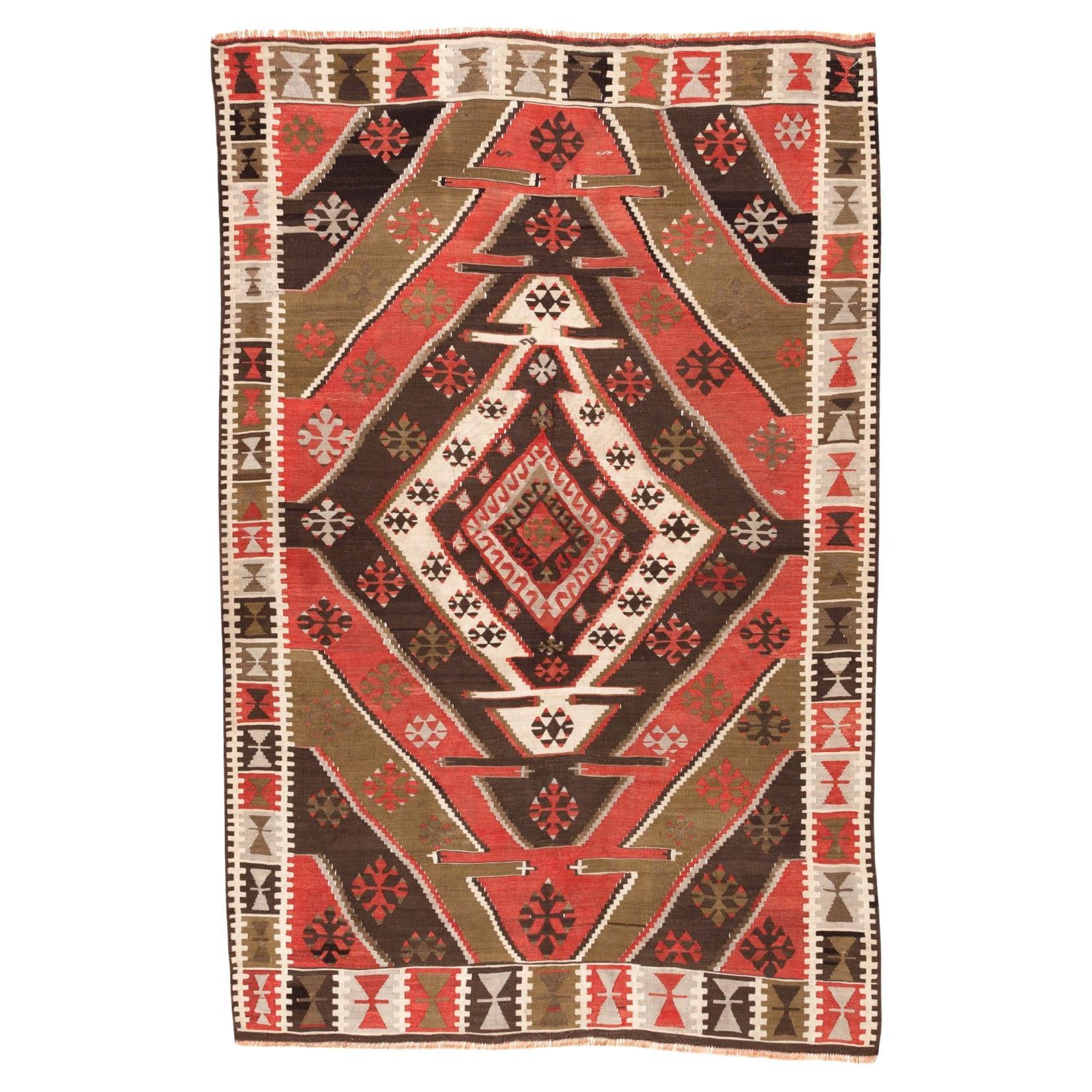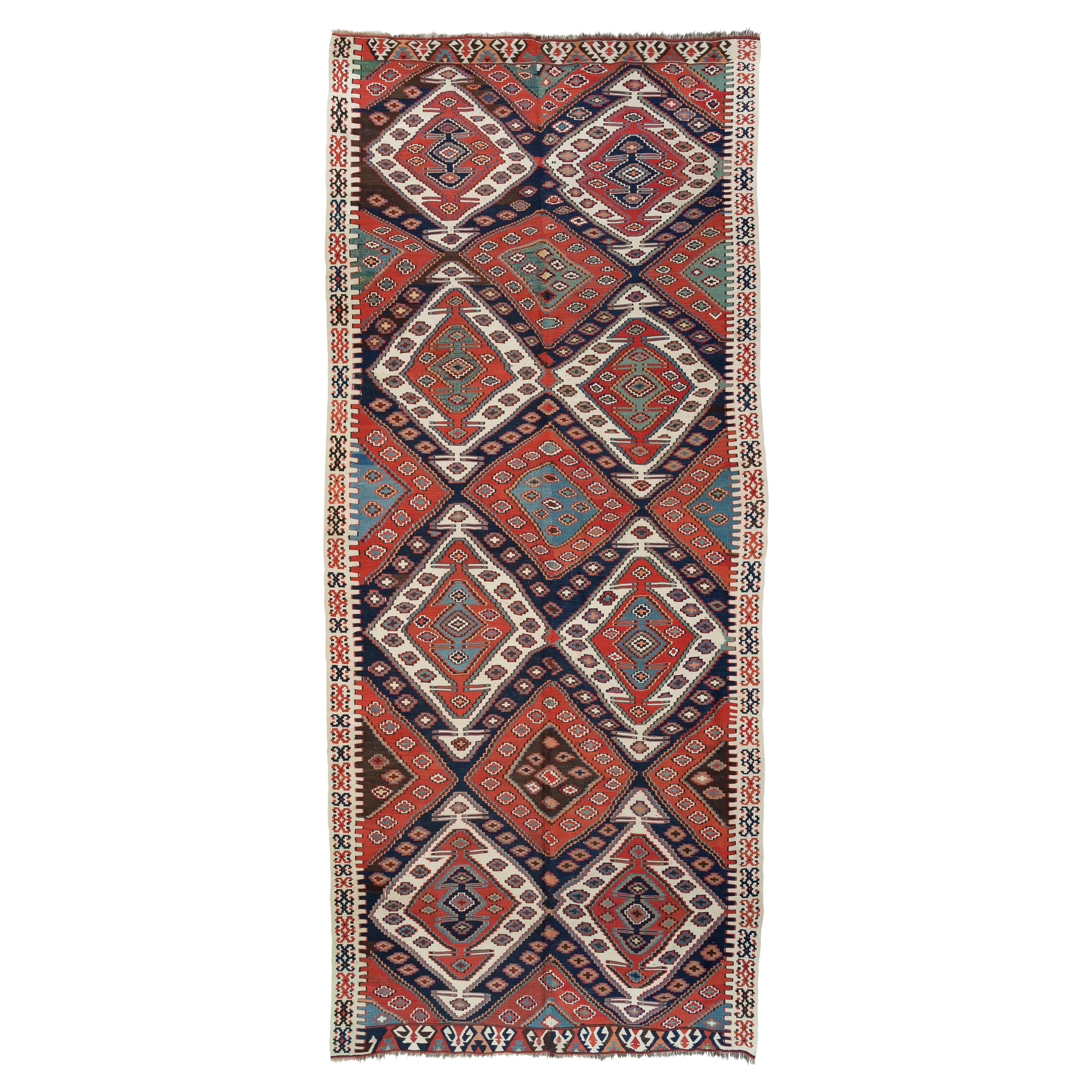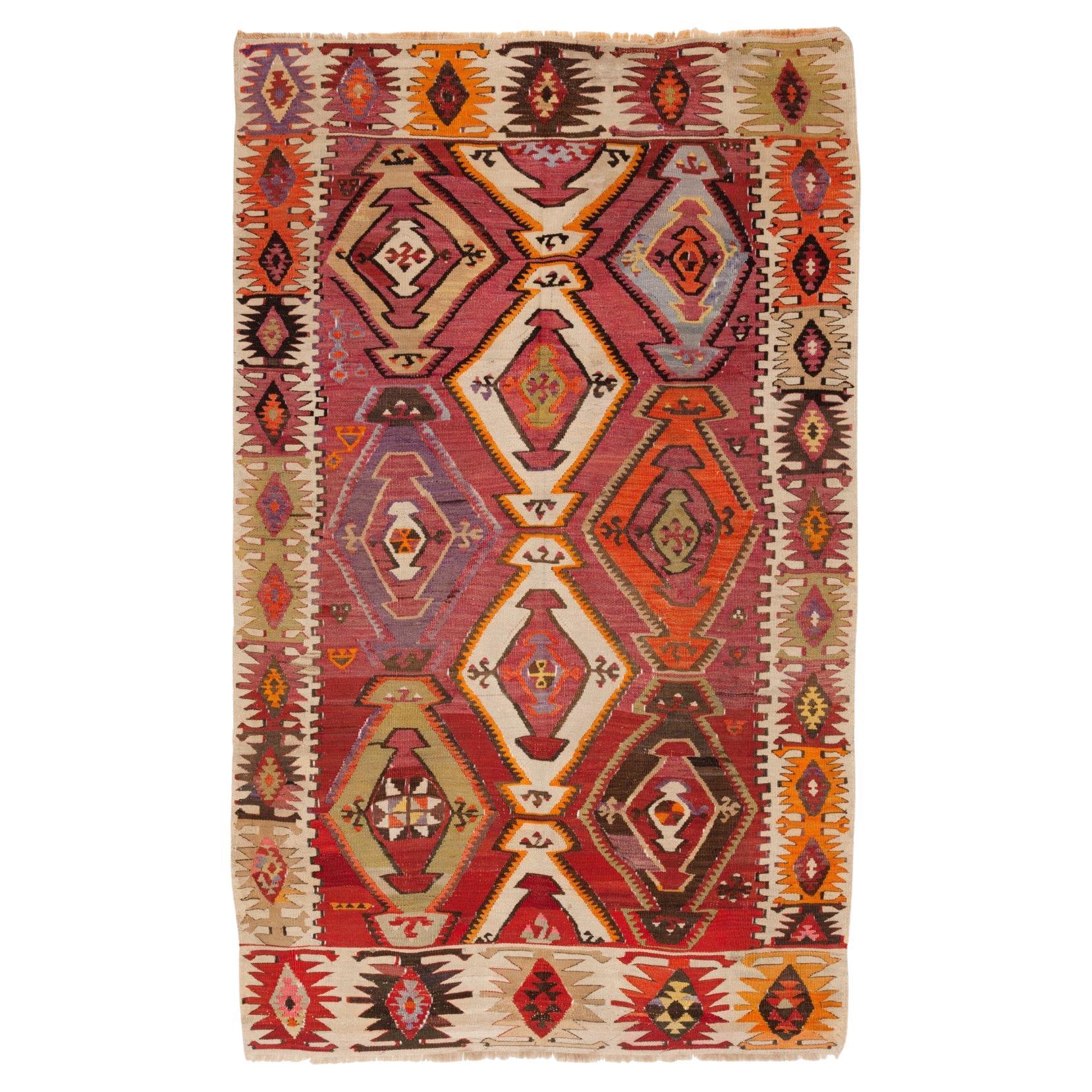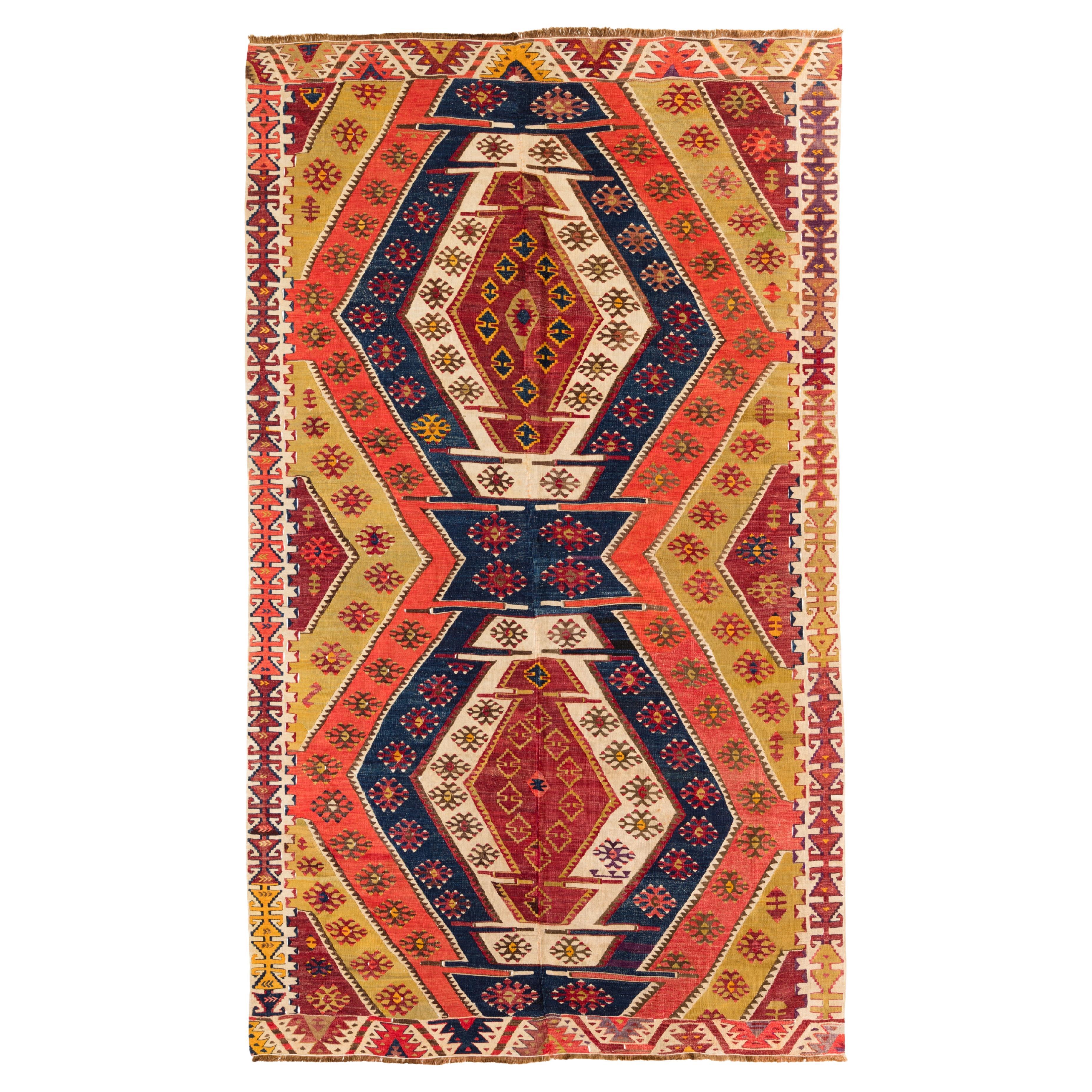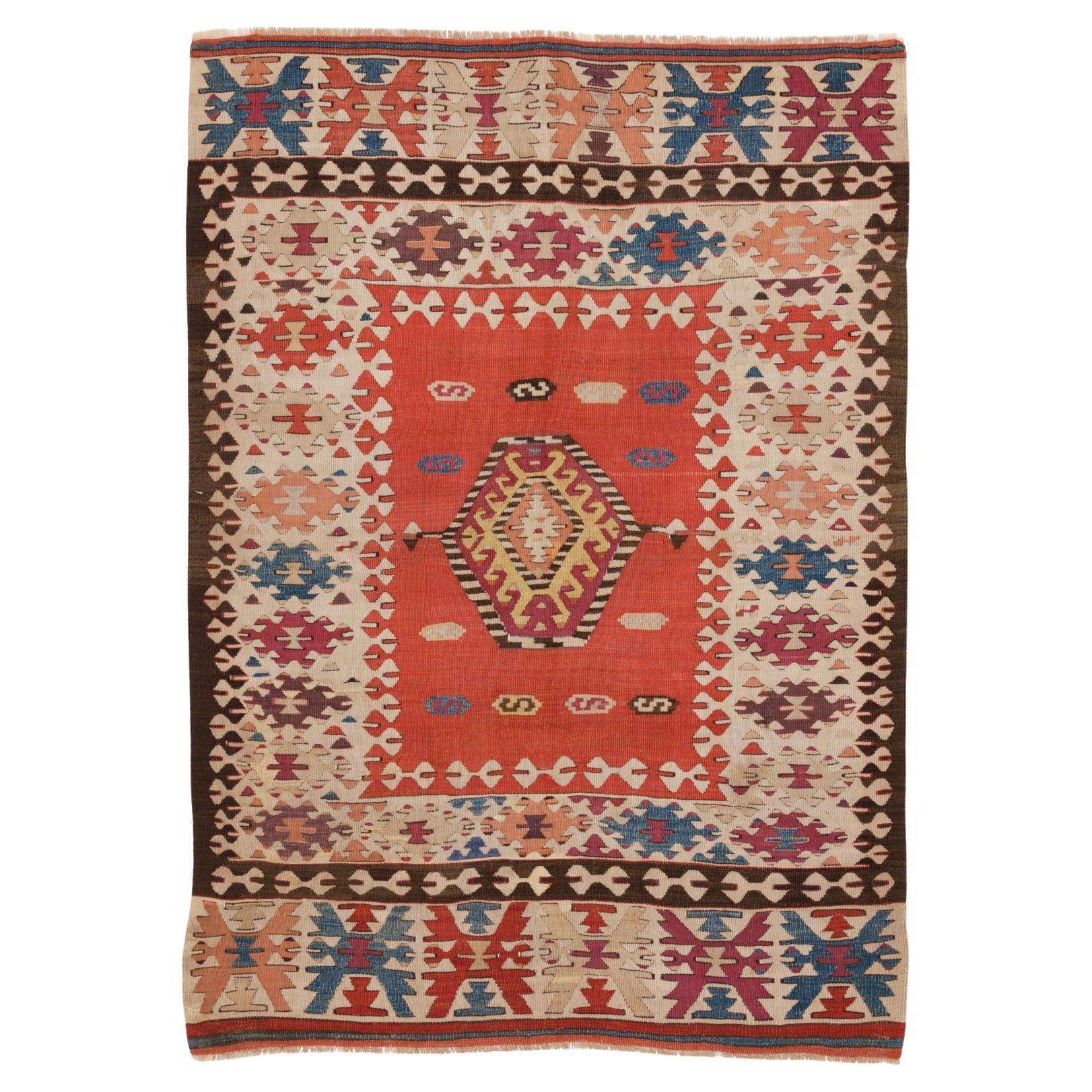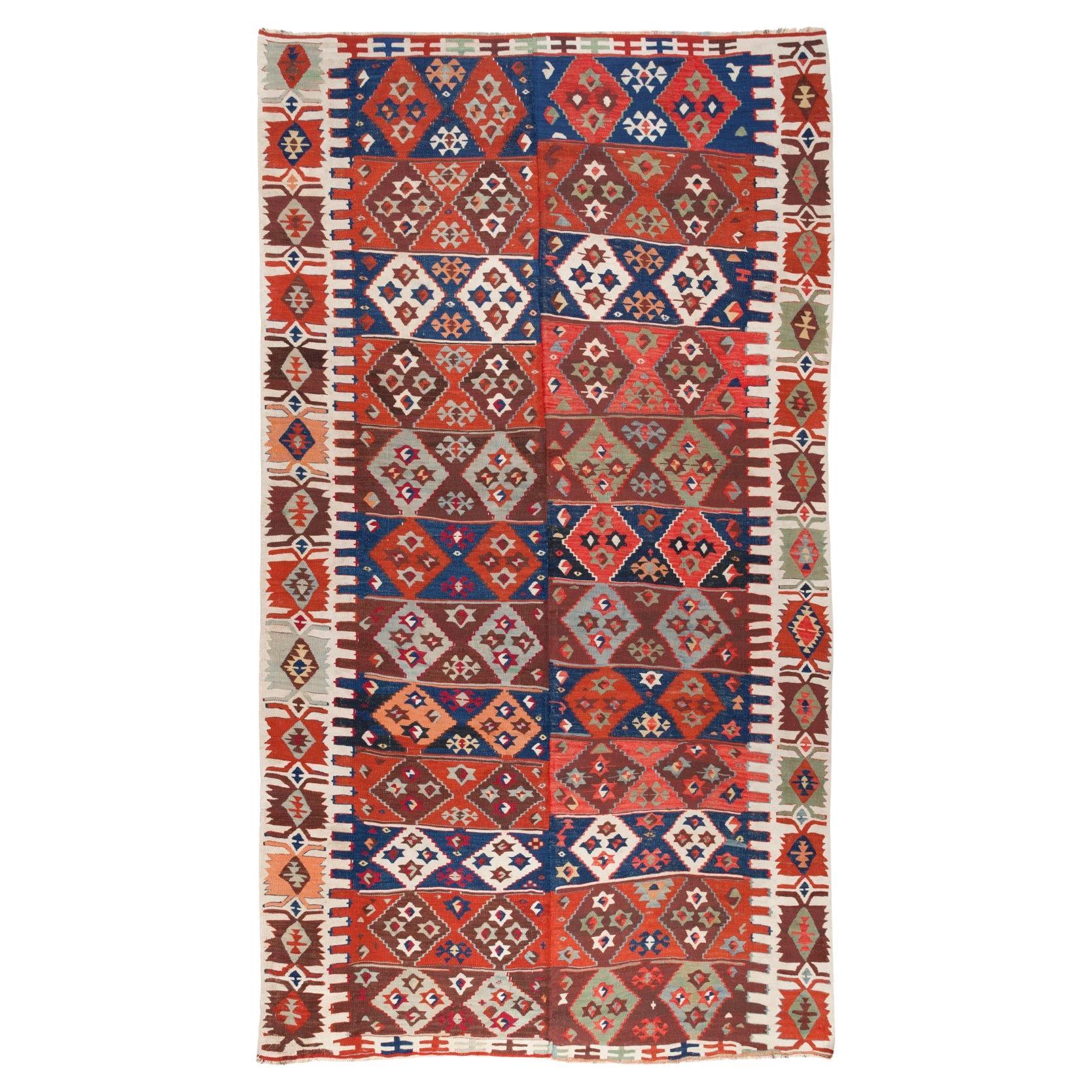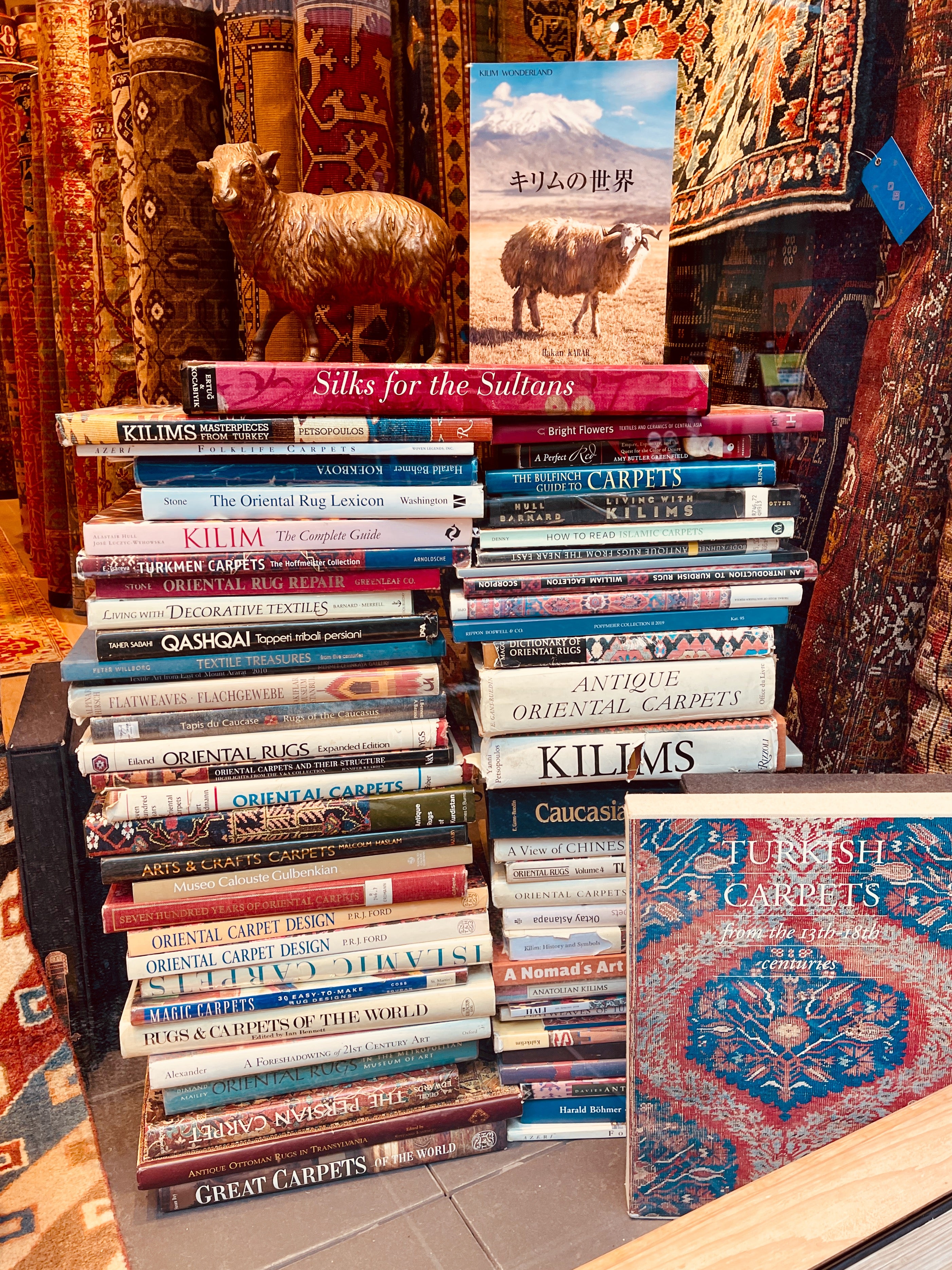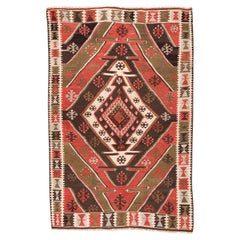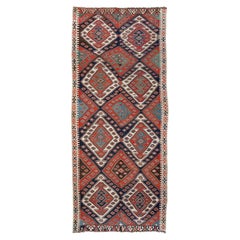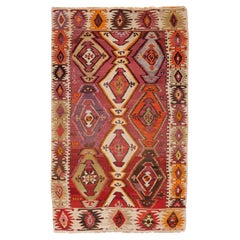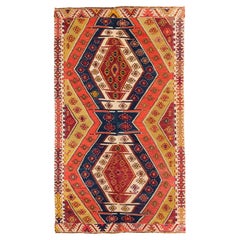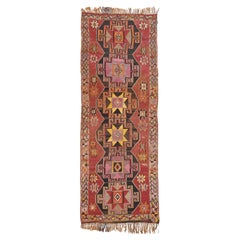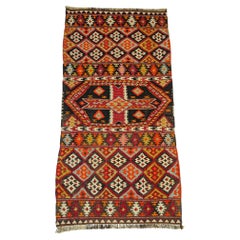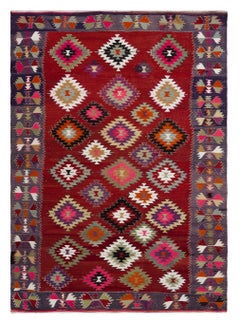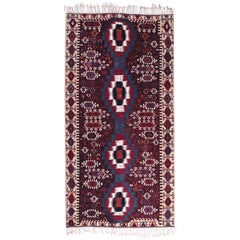Items Similar to Rashwan Malatya Kilim Rug Wool Old Vintage Eastern Anatolian Turkish Carpet
Video Loading
Want more images or videos?
Request additional images or videos from the seller
1 of 8
Rashwan Malatya Kilim Rug Wool Old Vintage Eastern Anatolian Turkish Carpet
$3,840
$4,80020% Off
£2,902.56
£3,628.2120% Off
€3,335.56
€4,169.4520% Off
CA$5,347.18
CA$6,683.9720% Off
A$5,948.51
A$7,435.6420% Off
CHF 3,118.29
CHF 3,897.8620% Off
MX$72,689.40
MX$90,861.7520% Off
NOK 39,707.48
NOK 49,634.3520% Off
SEK 37,379.10
SEK 46,723.8720% Off
DKK 24,898.71
DKK 31,123.3820% Off
Shipping
Retrieving quote...The 1stDibs Promise:
Authenticity Guarantee,
Money-Back Guarantee,
24-Hour Cancellation
About the Item
This is Eastern Anatolian Antique Kilim from the Rashwan, Malatya region with a rare and beautiful color composition.
The difference in dyeing on the left and right sides is proof that it was handmade by one person who took a lot of time to weave it. Because the yarn is spun, dyed, and woven while moving, it is never dyed the same color twice. If the wool is natural, the color and quality of the dye will change under various conditions, such as the original hair color of the wool, the weather during dyeing, and the quality of the dye.
This highly collectible antique kilim has wonderful special colors and textures that are typical of an old kilim in good condition. It is a piece that allows you to feel the beauty of Kilim-like colors and the texture of the old in the best condition.
As early as the 13th century Marco Polo noted, in his account of his travels to the region, that superlative rugs were to be found in the Konya area. Fortunately, the art of weaving good kilims has not died out even today, for there are small quantities of kilims still being made with hand-spun wool and mainly natural colors. As the capacity for such production is not large and prices remain high, it is unlikely that commercialism will corrupt these enterprises.
Konya, in south-central Anatolia, was the capital of the Seljuk Empire from the mid-eleventh to the thirteenth century and was in its prime during that period. Many of Konya's impressive buildings were constructed at that time by the Seljuk sultans in an architectural style reflecting Persian and Byzantine influence. Previously known as Iconium, this is one of the oldest urban centers in the world: according to Phrygian legend, Konya was the first city to rise from the waters after the great flood. Excavations here have revealed bones from the Bronze Age (c. 3000 BC). In the third century, the town was mainly occupied by the Greeks.
Konya has always been an important center for religion, culture, and trade, and also as a collection point for the many weaving centers nearby. The mystical order of the Whirling Dervishes was established in the town in the twelfth century by Mevlana Celal ad-Din ar-Rumi, an Afghan from Balkh, and a dervish festival is held in Konya during December. This festival is tolerated but has suffered government oppression since the time of Ataturk. During Ottoman times the dervishes were powerful, but Ataturk viewed the group as contrary to the modern development of Turkey, and many monasteries have now been turned into museums. Konya continues to be a very religious place and presently is becoming even more so.
Konya kilims feature the most varied compositions found in Anatolia, and there have been a great number of kilims made there over the centuries. Old Konya kilims still occasionally appear on the market today - but not necessarily in Konya itself. Although patterns are very diverse, they generally have much decoration covering the whole field of the kilim - a design format of large hexagonal motifs with extending hooked arms is a well-known characteristic. Again, a great variety of colors is used, most often of a lighter palette than in eastern Anatolia. Some very fine kilims have emerged, but in general, the kilims are of the medium-fine texture of weave, mostly made in slitweave technique with some çiçim. New kilims tend to be woven on thick warps. Konya kilims are made in all sizes, although there are fewer medium sizes. Ladik, Çumra and Eregli all lie close to Konya. Ladik is best known for its carpet production. It does, however, produce kilims that often have tulip motifs incorporated into the design. Weaving in Çumra has long since ceased, but the kilims that remain are very similar. Recent Eregli kilims are well made with good wool and tend towards the dark colors that greatly benefit from sun-fading.
- Dimensions:Width: 59.06 in (150 cm)Length: 86.62 in (220 cm)
- Style:Kilim (In the Style Of)
- Materials and Techniques:
- Place of Origin:
- Period:
- Date of Manufacture:circa 1950s
- Condition:Wear consistent with age and use. Minor losses. Minor fading.
- Seller Location:Tokyo, JP
- Reference Number:Seller: 233921stDibs: LU8206238200532
ARARAT RUGS
We know and believe that the geography we come from, our past, and our lifestyle are the most important bond between us to carry the oriental carpet art and culture to the next generations along with our core values in our ongoing growth journey.
We are aware that the way to achieve this goal and carry this priceless art and culture to the future depends on a lot of work with all our people every day while adhering to our core values.
For us, art is meaningful in the sense that it brings together various cultures around the world. It is an honor for us that oriental carpet art and culture have been instrumental in this for centuries and that we are a part of this business.
We are tirelessly keeping an eye on auction house information around the world about carpets. New York's Metropolitan, London's Victoria & Albert Museums, and other famous art museums, as well as small specialized museums that house private collections, and books about oriental carpets to collect information on outstanding carpet designs and patterns from around the world. It's our Self-improving and Self-developing culture.
As Turkish Culture of Hospitality, the Kurdish Culture of Generosity, and as Japanese Culture of Business Punctuality; are the most important values that this multicultural background has taught and bequeathed to us. It is essential and valuable for us that you feel this feeling not only by looking at our oriental carpets but from the moment you contact us.
About the Seller
5.0
Platinum Seller
Premium sellers with a 4.7+ rating and 24-hour response times
Established in 1970
1stDibs seller since 2023
55 sales on 1stDibs
Typical response time: 3 hours
- ShippingRetrieving quote...Shipping from: Tokyo, Japan
- Return Policy
Authenticity Guarantee
In the unlikely event there’s an issue with an item’s authenticity, contact us within 1 year for a full refund. DetailsMoney-Back Guarantee
If your item is not as described, is damaged in transit, or does not arrive, contact us within 7 days for a full refund. Details24-Hour Cancellation
You have a 24-hour grace period in which to reconsider your purchase, with no questions asked.Vetted Professional Sellers
Our world-class sellers must adhere to strict standards for service and quality, maintaining the integrity of our listings.Price-Match Guarantee
If you find that a seller listed the same item for a lower price elsewhere, we’ll match it.Trusted Global Delivery
Our best-in-class carrier network provides specialized shipping options worldwide, including custom delivery.More From This Seller
View AllRashwan Kayseri Kilim Rug Wool Old Vintage Eastern Anatolian Turkish Carpet
Located in Tokyo, JP
This is Eastern Anatolian Antique Rashwan Design Kilim, from the Kayseri region with a rare and beautiful color composition.
This highly collectible antique kilim has wonderful spec...
Category
Early 20th Century Turkish Kilim Turkish Rugs
Materials
Wool, Natural Fiber
Antique Rashwan Malatya Kilim Anatolia Rug Turkish Carpet
Located in Tokyo, JP
This is a Southern Anatolian Antique Rashwan Kilim from the Malatya region with a rare and beautiful color composition.
It is a large, 4 meters long Kilim with two halves attached...
Category
Early 20th Century Turkish Kilim Turkish Rugs
Materials
Wool, Natural Fiber, Organic Material
Rashwan Kayseri Kilim Rug Wool Old Vintage Eastern Anatolian Turkish Carpet
Located in Tokyo, JP
This is Eastern Anatolian Antique Rashwan Design Kilim, from the Kayseri region with a rare and beautiful color composition.
This highly collectible antique kilim has wonderful spec...
Category
Early 20th Century Turkish Kilim Turkish Rugs
Materials
Wool, Natural Fiber
$3,400 Sale Price
20% Off
Free Shipping
Rashwan Malatya Kilim Rug Wool Old Vintage Eastern Anatolian Turkish Carpet
Located in Tokyo, JP
This is Eastern Anatolian Antique Kilim from the Rashwan, Malatya region with a rare and beautiful color composition.
This highly collectible antique kilim has wonderful special col...
Category
Mid-20th Century Turkish Kilim Turkish Rugs
Materials
Wool, Natural Fiber
Antique Isparta Kilim Rug Wool Old Vintage Central Anatolian Turkish Carpet
Located in Tokyo, JP
This is Central Anatolian Antique Kilim, from the Isparta region with a rare and beautiful color composition.
This highly collectible antique kilim has wonderful special colors and ...
Category
Early 20th Century Turkish Kilim Turkish Rugs
Materials
Wool, Natural Fiber
Antique Adana Kilim Rug Wool Old Eastern Anatolian Turkish Carpet
Located in Tokyo, JP
This is Eastern Anatolian Antique Kilim from the Adana region with a rare and beautiful color composition.
This highly collectible antique kilim has wonderful special colors and tex...
Category
Early 20th Century Turkish Kilim Turkish Rugs
Materials
Wool, Natural Fiber
You May Also Like
Vintage Mid-Century Anatolian Gallery Size Kars Kilim Rug
Located in Milan, IT
A gallery-sized example of flat-woven wool kilim originating from Kars, located in eastern Anatolia close to the border with the Caucasus. The kilims from this region are renown for ...
Category
Mid-20th Century Turkish Kilim Turkish Rugs
Materials
Wool
Vintage Malatya Kilim South Anatolia Nomadic Rug Turkish Carpet
Located in North Hollywood, CA
Vintage Malatya Kilim South Anatolia Nomadic Rug Turkish Carpet.
Southern Anatolian Antique Kilim from the Malatya region with a rare and beautiful...
Category
Mid-20th Century Turkish Islamic Turkish Rugs
Materials
Wool
6.3x8.6 Ft Vintage Handmade Kilim. Flat Weave Turkish Rug. Wool Floor Covering
Located in Spring Valley, NY
A colorful Turkish Kilim (flat-woven rug) in excellent original condition. It is finely handwoven with natural wool. Measures: 6.3 x 8.6 Ft.
This gorgeous Kilim features stepped d...
Category
Mid-20th Century Turkish Kilim Turkish Rugs
Materials
Wool
$1,275 Sale Price
50% Off
Free Shipping
Antique Central Anatolian Kilim Rug
Located in New York, NY
Antique Central Anatolian Kilim rug. A great example of Anatolian Kilim rug weaving from the 19th century when tribal women wove such pieces as...
Category
Antique Late 19th Century Turkish Kilim Turkish Rugs
Materials
Wool
Old Anatolian Turkish Konya Region Prayer Kilim, Circa 40 Years Old
Located in Moreton-In-Marsh, GB
Old Central Anatolian Konya region prayer kilim
About 40 years old
A good kilim with pleasing colour and design
Excellent condition with no wear at all
Hand washed and ready for u...
Category
20th Century Turkish Turkish Rugs
Early 20th Century Persian Azari Kilim Rug
Located in Chicago, IL
A beautiful early 20th century Persian Azari Kilim rug with four large geometric stylized flowers amidst a field of more stylized flowers arranged into stripes across the field, and ...
Category
Vintage 1940s Persian Kilim Persian Rugs
Materials
Wool
More Ways To Browse
Vintage Turkey Decorations
Industrial Metal Table Legs
Italian Side Table Drawer
Meissen Mark
Travertine Block
Twisted Wood Chair
Vintage Floral Paintings
Vintage Industrial Office Chair
Wood Carving Wall Sculpture
1950s Glass Top Coffee Table
Antique Limoges
Antique Walnut Marble Top Table
Antique Window Display
Brass Wood Round Dining Table
Bright Group
Capron Vallauris
Chinese Rectangular Table
Classic Lighter
